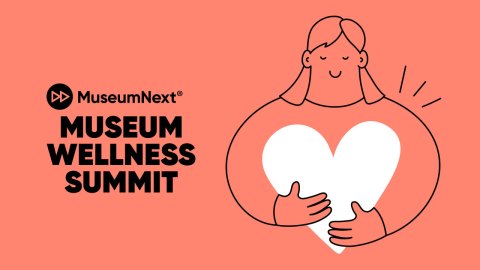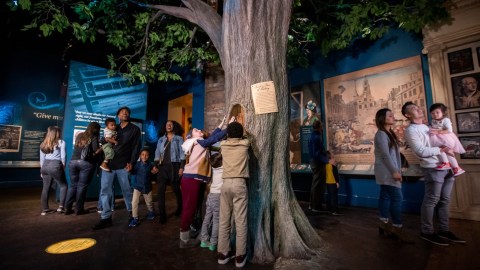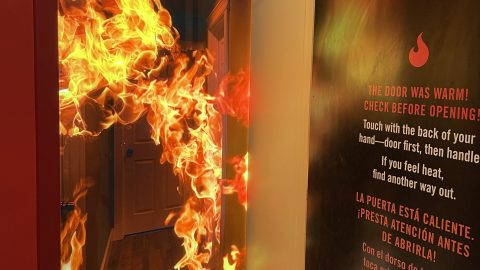
This article first appeared in the journal Exhibition (Fall 2025) Vol. 44 No. 2 and is reproduced with permission.
In Fall 2023, Lehigh University Art Galleries (LUAG) launched its Access Culture initiative, a six-part professional development series facilitating arts professionals in appropriately and effectively engaging with audiences with disabilities. Initially funded by the Pennsylvania Council on the Arts, Access Culture has since expanded into robust community partnerships and programming for the Disability Community and space adaptations in the museum that have increased visitorship within and beyond the Disability Community. By working collaboratively with state funders, local community arts organizations, social service organizations, and among our staff to address internal barriers to accessibility, we have been able to work toward actionable strategies and changes in our museum.
This article will share the approach and results of LUAG’s Access Culture initiative, demonstrating how small museums—with small staffs, limited budgets, and time constraints—can actively center accessibility to support additional programming and initiatives. Access Culture offers one potential pathway for managing efforts around disability access in the arts and cultural sphere in a way that supports not only the communities these programs and accommodations are meant to serve, but also the arts administrators who are designing the experiences.

Access Culture
Located in Bethlehem, Pennsylvania, Lehigh University is a private, research-based institution widely known for its engineering and business schools. However, the arts have also been a central part of the university’s history since its founding in 1865. LUAG is celebrating its 100th anniversary in 2026; has over 20,000 objects in its collection; is free and open to the public; and is dedicated to advancing critical thinking, cultural understanding, and well-being for the campus and wider community through transformative experiences with art.
LUAG’s initial foray into access programming dates to 2015 and the 25th anniversary of the Americans with Disabilities Act (ADA). The museum partnered with the Lehigh Valley Arts Council’s Arts & Access Always Program, dedicated to inspiring inclusivity in the community by highlighting the arts and making them as accessible as possible to everyone interested. After participating in sighted guide and audio description training, former staff members at the museum were able to build a foundational relationship with the Blind and Low Vision (BLV) community in the Lehigh Valley. As part of these efforts, the museum developed over 70 audio descriptions for works in the permanent collection and collaborated with students to develop hand-built tactiles to accompany them (fig. 1). These efforts were the origins of the museum’s ever-expanding accessibility offerings.
As our staff and capacity have grown, updates to strategic planning initiatives and priorities have developed. Improved accessibility practices are a core commitment of LUAG’s strategic plan, with a focus on growing community partnerships and inclusion efforts to broaden audiences and access. In 2019, LUAG hired Stacie Brennan to be its inaugural Curator of Education, and then, in 2021, it hired Elise Schaffer (the author) as its first Coordinator of Museum Experience and Accessibility. Both Brennan and Schaffer came to LUAG with strong backgrounds and experiences in accessibility work.
LUAG was, therefore, well-positioned when the Pennsylvania Council on the Arts put out a request for proposals—Serving Audiences with Disabilities in the Arts—in 2024. This opportunity opened new doors for the Education and Outreach team, as it provided funding specifically for accessibility work in the museum. Our proposed program, intentionally titled Access Culture, referred not only to the culture of accessibility within our institution, but to the need for accessibility to become a stronger and more integral part of how our organization and other local arts and cultural organizations approached the culture of being accessible, inclusive, and welcoming.

The premise was straightforward: LUAG would start by using the provided funding to make updates to the museum’s print and digital resources, creating a change in how and where potential patrons might find information about the organization before their visit. Oftentimes, accessibility considerations are an afterthought, causing costly and poorly integrated solutions to existing barriers. However, accessibility considerations made in advance with planning and community participation can be effective and well-integrated into exhibition spaces, programming, and organizational culture.
The first step for our organization was to address as many readily achievable accessibility changes as possible. These included no- to low-cost solutions such as updates to the visitor page on our website, developing and installing directional and wayfinding signage around the galleries, and conversations with the exhibitions team around cane-detectable cases and pedestals. We were very intentional about which changes we could realistically make and share with our learning community, striving to serve as a model for how organizations can provide a welcoming and inclusive environment. Putting this work into practice and testing audiences’ reactions has allowed us to develop best practices and approaches for building an inclusive culture and space that we can share with others.
Next came the launch of Access Culture’s core professional development programming for artists, arts educators, and arts administrators in the Lehigh Valley, an area rich with arts and cultural experiences and organizations that is also home to a large and present Disability Community. The museum worked collaboratively with members of the Disability Community to design and present workshops and to compensate these educators and advocates for their time.

Our original goal was to engage arts administrators from five local organizations. As of Spring 2025, we have welcomed over 100 individuals from organizations all over Southeastern Pennsylvania to participate in Access Culture. Participants have included university students with an interest in access, members of the Disability Community hoping to learn more about other types of accommodations, and arts and cultural workers from museums, theaters, historic sites, and government entities.
A selection of workshops and partnerships facilitated through Access Culture includes:
- Sighted Guide Training with Rita Lang, Client Activities Manager at Sights for Hope (fig. 2)
- Cultivating Neurodivergent Accessible and Inclusive Arts Spaces with local artists and educators Rain Black and Robin Gow
- Moving Access from Compliant to Creative with Thomas Reid and Cheryl Green of the Social Audio Description Collective
- Exploring Art with Audio Description and Tactile Elements with Elise Schaffer (author)
- Creatives in Community: Understanding the Foundations of Well-Being with Connor Moriarty and Khalid Taylor of Reset Outdoors
- Developing Tactile Education Materials for Museum & Gallery Tours with Rita Lang, Sights for Hope, and Margie Makowski from the Allentown Art Museum
We hope that as the program expands, a cohort of accessibility advocates will emerge in the Lehigh Valley arts community that can support one another in the ongoing work of accessibility. As one participant states:
Throughout my participation in the Access Culture program, I have truly enjoyed learning from and alongside local colleagues, artists, and arts administrators who are passionate about accessibility. The program has provided an invaluable space for meaningful conversation and the exchange of thoughts, experiences, and ideas on best practices each time our cohort comes together. This type of training is essential in the arts and cultural sphere, as it not only sparks vital conversations but also fosters ongoing dialogue for continuous improvements to ensure that creative spaces and experiences are accessible to everyone.[i]
The intention is to empower participants to engage in authentic and potentially difficult conversations around arts and access in our work and community.
Moving Toward Greater In-Gallery Accessibility
In addition to the work of Access Culture, LUAG has made internal changes to prioritize the accessibility of our galleries, ensuring that the spaces are not only welcoming but comfortable and radically hospitable for visitors of all ages, backgrounds, and abilities.[ii] The Access Team (comprised of Schaffer and Brennan; Allyshia Mohr, LUAG Visitor Services Assistant; and Micaela Cortese ’26, Lehigh University student and LUAG Accessibility Intern) champions accessibility through smaller, more approachable changes to programming, messaging, and our everyday operations at the museum. For example, the team works together to build pre-visit and virtual tours, update language regarding accessibility on gallery and marketing materials, train students and gallery staff, and make suggestions for access considerations for exhibitions, events, and programming. This has amounted to an uptick in requests for accommodations from patrons—including American Sign Language interpretation, captioning services, and audio description—as well as requests for quiet space during events, sound-reducing headphones, curb-to-seat guides, and other accommodations now readily offered at LUAG.
This increase in requests is a direct result of our commitment to accessibility. Every event listing includes an access statement that lets visitors know who to contact to request accommodations. In addition, all event registration forms include an Accessibility Information section so that accommodations can be requested directly through a guest’s registration or RSVP. The list of choices includes:
- American Sign Language Interpretation (2 weeks’ notice)
- Automatic Captioning
- CART (Communication Access Realtime Translation) Captioning (2 weeks’ notice)
- Curb-to-Seat Guide
- Diet Restrictions or Allergies (please specify)
- Large-Print Handouts
- Quiet or Relaxation Space during Event
- Sighted Guide Assistance
- Wheelchair Access
Upon registration, an email is automatically sent to the museum’s Access Coordinator alerting them of the request. This way, the accommodation or access provider can be booked, details coordinated with the teaching artist or museum educator, and front desk staff notified to provide any necessary information or technology to participants upon check-in. This streamlined communication channel not only creates a better experience for visitors but also prepares staff to best welcome visitors who have specific needs so that they are able to participate and engage equitably.


While it may seem like a simple strategy, sharing accessibility information up front helps set clear expectations for visitors and the institution. It communicates what is already available and what can be easily requested based on the individual’s needs. This kind of transparency has not only led to an increase in accommodation and access service requests but has also helped the museum better understand which services are most in demand, allowing the team to better and more consistently integrate these into our standard offerings. In addition, a more thorough accessibility page was created on the LUAG website to provide information to potential visitors.
Audio Descriptions
The Access Team is also responsible for the museum’s ever-expanding audio description offerings. LUAG’s audio descriptions are available via QR codes in the galleries or online via various podcasting platforms for those who may prefer to listen at home. Audio description enhances accessibility by bringing visual images to life for people who are B/blind or have low vision (BLV). Through detailed narration, they capture the essential visual elements that sighted individuals might take for granted, providing a vivid and alternative way to experience art (fig. 3).
This program began with the writing and development of descriptions for select works in the permanent collection, followed by multiple rounds of editing and feedback with paid participants connected with LUAG through the American Council of the Blind and our local center, Sights for Hope (fig. 4). Participants were compensated $60 per session and had the opportunity to sign up for one or all three sessions. Each session featured descriptions that varied from contemporary to historical art and cultural heritage objects in the collection. Feedback sessions were conducted via Zoom to accommodate schedules and those who may not have reliable access to transportation.
At each of the three 90-minute sessions conducted by the Access Team, drafts of audio descriptions were read to participants who then had time to ask clarifying questions and provide feedback on what they liked and disliked or what might be improved. Detailed notes were taken and returned to the team following sessions so that edits and improvements could be made.
As part of each session, we also asked participants how they preferred to access the descriptions—for example, through their individual devices, having them read aloud by a tour guide, or online from home in advance of their visit. Due to this feedback, we have made all modes of accessing the descriptions available. LUAG pays a monthly subscription to Spotify as well as a distribution platform called Transistor. These low-cost tools allow LUAG to provide better access to audio descriptions and a more independent experience for users.
These tools also allow for easy and anonymous tracking of how many users utilize these resources and where they are accessed. This fall, LUAG will be adding Bloomberg Connects to our list of available tools, further expanding in-gallery and external access to the exhibitions and educational materials available.
In 2024, thanks to a grant from the Art Bridges Foundation, LUAG hosted Really Free: The Radical Art of Nellie Mae Rowe, an exhibition of works from the High Museum of Art in Atlanta, Georgia. The exhibition featured 58 works by self-taught artist Nellie Mae Rowe and was accompanied by funding for exhibition design and learning and engagement. This funding allowed LUAG to work with the Social Audio Description Collective to create a selection of blind-centered audio descriptions of Rowe’s work. This was an incredible learning opportunity for our team and patrons, expanding our knowledge and appreciation of audio description created in many forms. In addition to their work focused on audio description for this exhibition, Thomas Reid and Cheryl Green from the Social Audio Description Collective provided a training around audio description and media access as part of Access Culture’s professional development programming, illuminating how cultural organizations can focus on creative and impactful solutions to accessibility barriers, rather than mere legal compliance.
Tactile Reproductions and Other Interventions
These collaborations and consultations have opened wider conversations and creative solutions to accessibility issues and barriers in our programming and spaces at the museum. Following a reinstallation of the museum’s Lower Gallery in Summer 2024, the exhibitions team worked closely with education staff to make accessibility-related changes to the physical space. For example, LUAG’s Head Preparator and Exhibition Designer, Jeffrey Ludwig-Dicus, and Preparator and Collections Specialist, Khalil Allaik, created specially designed shelving and exhibit space for a tactile representation of Dialogando by Joaquín González(fig. 5).This tactile piece was created in collaboration with the Clovernook Center for the Blind and Visually Impaired, founded in 1914, a leader in producing braille and tactile graphics. This tactile was paired with an audio description of the work and installed in the gallery space for everyday use, rather than kept in an education closet for guided tours only (fig. 6). In an ideal world, all visitors would be empowered by accessibility considerations to experience the museum independently and explore without assistance. In service of that goal, a permanently installed tactile work of art creates broader access for BLV patrons at the museum. As the team works to develop additional tactile resources and experiences, this space will forever be dedicated to displaying artwork from the collection alongside tactile interpretations.
Other changes to exhibition spaces include increased font size for wall labels, QR codes on labels for audio-described works on view, additional gallery seating, interactive education stations, sensory kits and fidgets for visitors, considerations around hang and pedestal heights to ensure accessibility, adjustable lighting in the gallery spaces, braille exhibition booklets, and the creation of additional tactile materials for the education team to use in lessons and programming. These changes, while seemingly incremental and small, can have a significant impact on an individual’s experience in the museum.
In Spring 2025, LUAG hosted the Art, Architecture and Design Faculty Exhibition. Special considerations needed to be made for work in the exhibition displayed on sawhorses that would otherwise lack the necessary cane detectable height for members of the BLV community who might use mobility canes (intro image). This creative solution, designed by Ludwig-Dicus, was the result of collaboration between access and exhibition design staff at the museum, who engaged in many conversations about what was needed in the exhibition space for visitors of all abilities. Additionally, this exhibition’s labels were created with much larger print than previously available and accompanied by a large-print binder that could be checked out from the front desk. These accessibility considerations stemmed from proactive planning for access rather than the costly and complicated process of retrofitting after an issue arises.
What’s Next
As LUAG continues to expand access, community partnerships will be at the heart of it all. Our organization hopes to develop changes to our physical space and continue creating adaptations for incoming exhibitions and art on view. The museum will continue our work with paid focus groups and post-program evaluations to identify local organizations and services led by individuals with disabilities to help inform our programming and resources.
Throughout our journey toward expanded access, our staff has been thrilled to have the opportunity to work with faculty and students in Lehigh University’s College of Health. Access and education staff have worked directly with students to develop and cultivate projects, surveys, and initiatives to expand access in the museum and to gauge the need for these types of services in our on-campus museum. In addition to these collaborations, staff continue to develop tools to measure the positive impact of these programs through a focus on outcomes-based approaches to program planning and implementation. This work is integral in demonstrating the importance of the arts in individual and collective well-being.
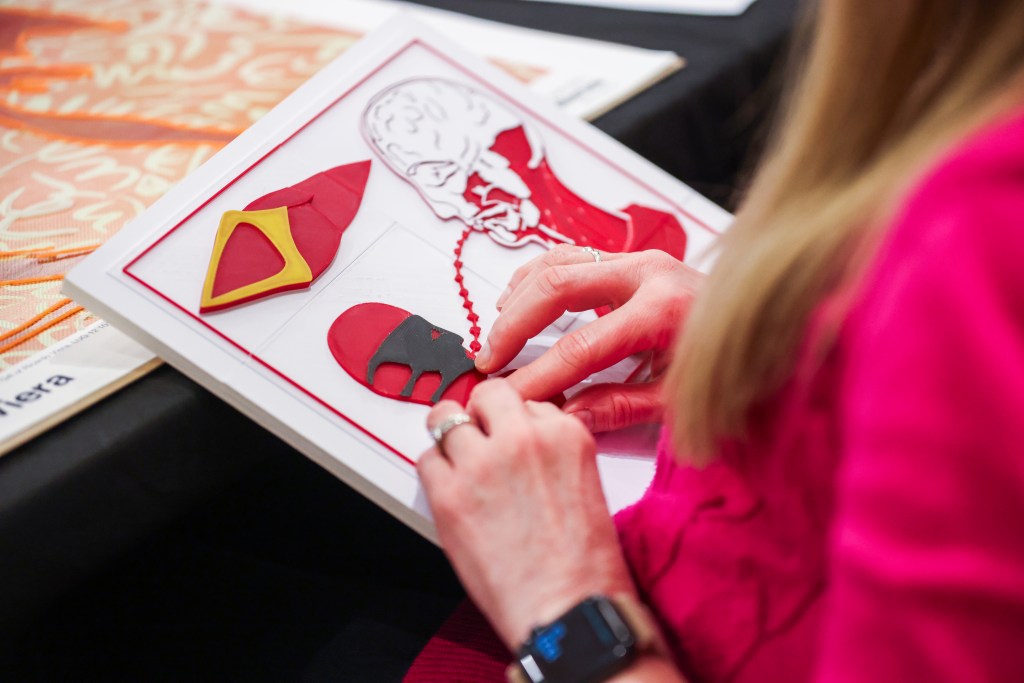
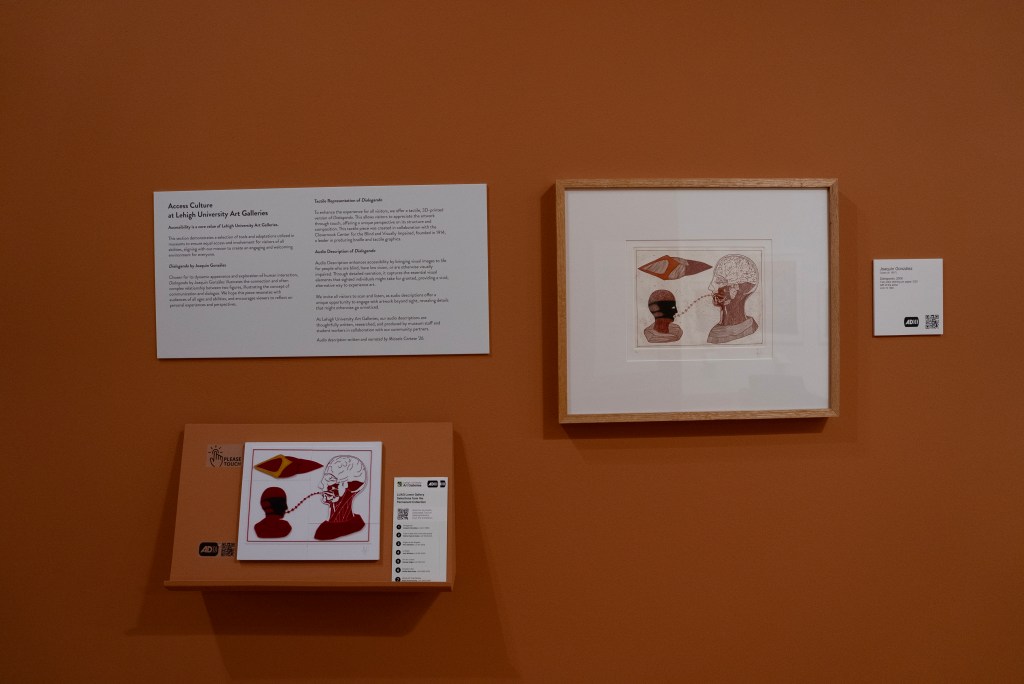
Moving forward, LUAG will work to expand the Access Culture program beyond professional development opportunities to encompass programming designed specifically for engagement with the Disability Community. In Spring 2025, LUAG hosted its first all-access public program exploring art with audio description and tactile elements, as well as inaugural community-led programs with the D/deaf and Hard-of-Hearing Community in our region. Our organization will maintain our solidarity with the Disability Community, remaining committed to removing barriers, providing access for all, and achieving diversity, equity, and inclusion through our programming and exhibitions.
Building Access at Your Organization
We offer the following lessons from our work for other institutions looking to build a culture of access:
- Seek out local partners.
Accessibility efforts at LUAG are continuously changing and shaped by insights from colleagues at organizations like Art-Reach in Philadelphia and the Lehigh Valley Center for Independent Living in Allentown, Pennsylvania, as well as through lessons learned from the Leadership Exchange in Arts and Disability Conference (LEAD) run by the Kennedy Center’s Access/VSA International Network, webinars through the ADA Network, and other experienced professionals in the field. Our team has had the pleasure of working with experienced arts accessibility professionals as well as receiving invaluable feedback from visitors and social service organization partners willing to share their experiences.
- Plan ahead.
Budgeting and the cost of services are among the most difficult barriers small arts and cultural organizations face. Institutions should plan and budget for the costs of access services or other incremental changes they are considering. Our organization started by identifying changes that could be made with minimal time and costs and moved outward based on the availability of funds. - Think sustainably.
Having organizational buy-in is important, as is including all staff in training programs and access initiatives. Cross-collaboration among departments is key to creating access across exhibitions, educational materials, visitor services policies, and more, and it also ensures that the changes that are made will be sustainable over time, as everyone in the organization will understand the part they play in their continuation. - Be creative.
Many of the projects and adaptations discussed here ensure that LUAG meets the legal requirements set by the ADA—but many go beyond this baseline. Something can meet legal requirements for access and still not be fully accessible. Rather than focusing on the legality of the work that you do, focus on the user experience by working with and compensating the community members you hope to serve. - Open lines of communication.
One of the biggest internal challenges museums face when working toward accessibility is the disconnect between departments—especially education/access/visitor service staff and collections and exhibition teams. Creating recurring, consistent planning meetings and times to discuss upcoming projects can help prevent last-minute, reactive accessibility updates. Instead, accessibility conversations become well-integrated into exhibition planning and gallery design. Don’t wait until the exhibition is already installed to start thinking about accessibility; start now!
Want to Get Involved?
While most Access Culture workshops and trainings are hosted at LUAG, all are invited to engage in the online Access Culture Discussion Group that meets monthly via Zoom to converse and collaborate on ongoing access projects in their respective organizations. We hope to see you there!
Elise Schaffer is Coordinator of Museum Experience and Accessibility at Lehigh University Art Galleries in Bethlehem, Pennsylvania. ejs421@lehigh.edu
[i] Margie Makowski, Manager of Museum Accessibility at the Allentown Art Museum, and Access Culture program participant via feedback form.
[ii] At LUAG, we define radical hospitality as ensuring that folks have a personal and meaningful experiences in our spaces in a way that prioritizes their comfort and equitable access.

